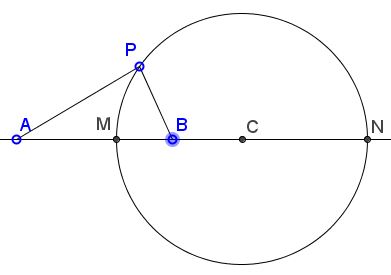Locus of Points in a Given Ratio to Two Points
Given two points A and B and a number r. What is the locus of points P such that
Created with GeoGebra
|Activities| |Contact| |Front page| |Contents| |Geometry|
Copyright © 1996-2018 Alexander Bogomolny
Apollonian Circles Theorem
Given two points A and B and a number r. What is the locus of points P such that
The locus is a circle, unless of course r = 1, in which case it's the perpendicular bisector of AB. The proof exploits the properties of angle bisectors: internal and external.
To see that (there is an additional proof), construct points M and N on the line AB such that

The circle at hand has MN as a diameter. Indeed, M serves as the feet of the internal bisector of triangle APB at apex P, PN serves as the external bisector. Therefore,
For any P on the circle, the internal and external bisectors of angle APB pass through (the fixed points) M and N.
The circle we just constructed is known as a Circle of Apollonius. The family of all such circles obtained for different values of r and fixed points A and B is known as the Apollonian Family of Circles defined by the points A and B. Note that one of these circles (corresponding to
Since, for the same A and B, each of the Apollonian circles correponds to a different r, no two Apollonian circles intersect. For
|Activities| |Contact| |Front page| |Contents| |Geometry|
Copyright © 1996-2018 Alexander Bogomolny
73558963
